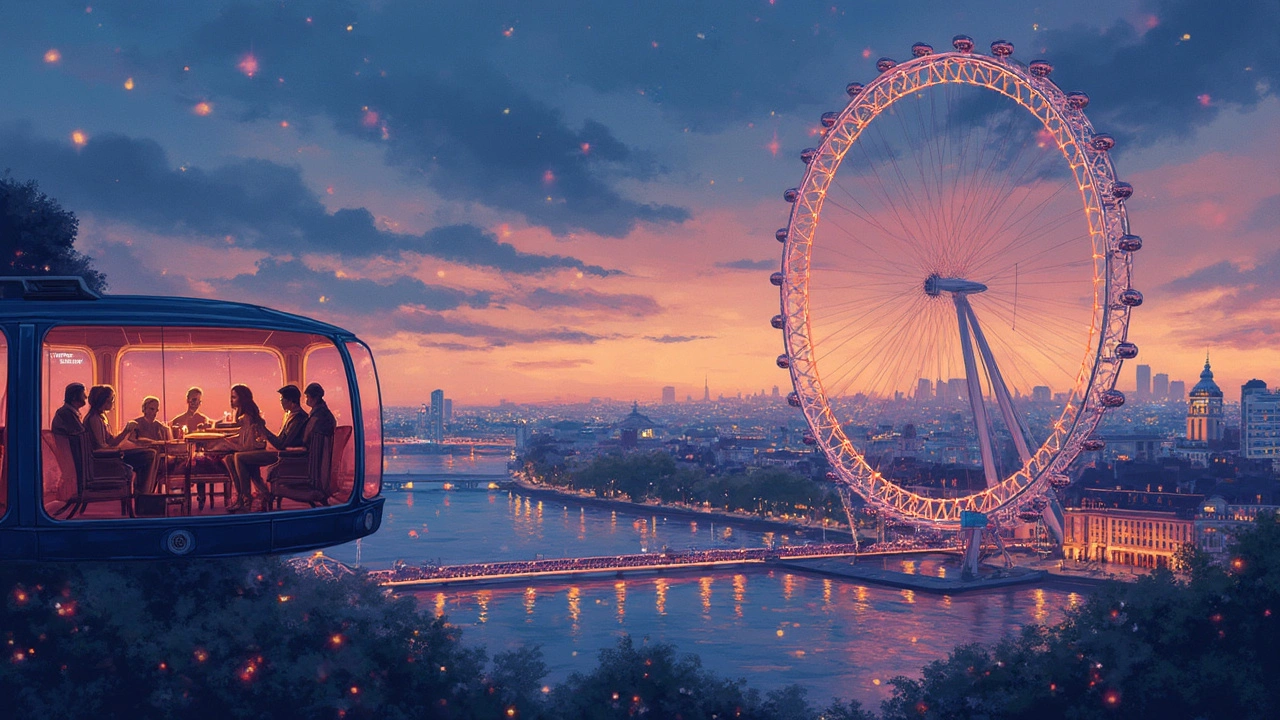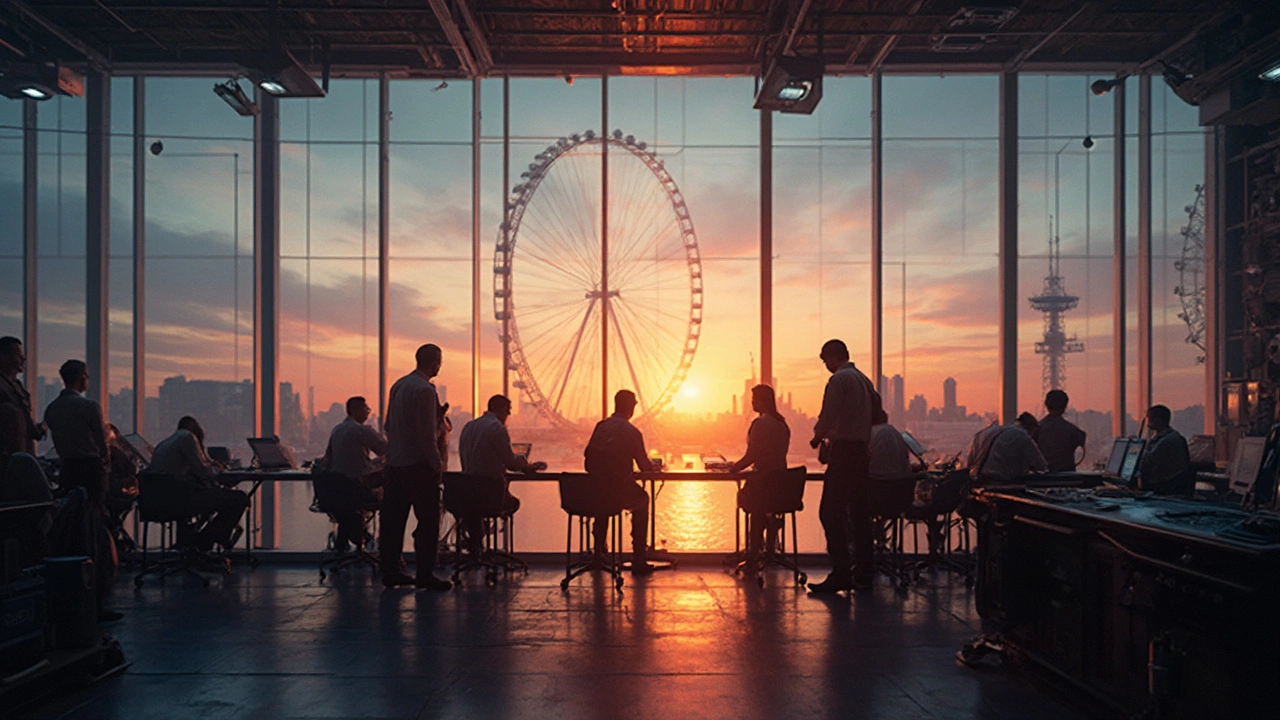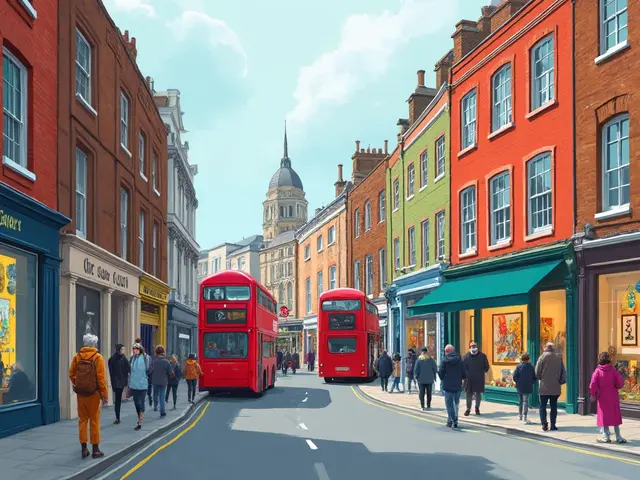If you’ve ever walked along the South Bank after work, you’ve probably glanced at that big wheel dominating the skyline—the London Eye. But ask a born-and-bred Londoner, and you’ll find most haven’t taken a proper spin. Weird, right? It’s always there, a part of the view, but rarely actually experienced by the people who call this place home.
Here’s the deal: the London Eye isn't just a tourist hotspot. It’s woven into everyday London life, lighting up for Pride, New Year’s, and even the odd Channel 4 stunt. Locals know to avoid peak times—weekends after lunch, bank holidays when the queue snakes all the way to Jubilee Gardens, and half-term chaos. Pro tip: go late evening on a weekday, right before closing, for emptier pods and the city glowing in golden hour light.
For families, there’s the Southbank Centre nearby for a pre- or post-ride snack, and Waterloo Station’s a quick stroll away if you’re hopping back to Clapham or Richmond. Thinking of splurging? The Fast Track tickets work out if time matters to you (nobody’s got patience for a queue in the drizzle). And Londoners—don’t forget to check if your employer or local Uni has partnerships for ticket discounts. Saves you a few quid and a bit of queue rage.
- Winding Up: A Quick History Lesson for Locals
- Not Just a Pretty Face: How the Eye Runs Daily
- Ticket Tricks: Getting the Best Experience
- Views You Didn’t Expect: Spotting London’s Secrets
- Events, Light-Ups, and Local Specials
- The Eye in London Life: Locals’ Stories & Tips
Winding Up: A Quick History Lesson for Locals
Loads of people mistake the London Eye for an old-school bit of city scenery, but it only started spinning right before the Millennium. It opened officially on 9 March 2000, though some preview pods ran in late 1999. Locals remember it being called the ‘Millennium Wheel’ before it settled into its current name.
Designed by a husband-and-wife architect duo, David Marks and Julia Barfield, it was a passion project after their original pitch for a big public landmark in the city got nowhere. Turns out perseverance works—now it’s as familiar as red buses or the Thames. Construction wasn’t your average building job either. The entire wheel was assembled on floating platforms on the river, and had to be hoisted upright, inch by inch, over several days. The sight stopped Waterloo commuters in their tracks. There were nerves—it was the biggest observation wheel in the world at the time. Never mind The Shard, for a brief moment, the Eye held court as the tallest landmark on the South Bank.
The original plan was to keep it up for just five years, but Londoners and visitors fell for those views, and the Eye stuck around. Now it draws over 3 million visitors a year, edging out even the Science Museum and Somerset House in the numbers game. A fun stat: on a clear day, you can spot Windsor Castle nearly 25km away from the top of the Eye. Not bad for a 30-minute spin.
| Fact | Detail |
|---|---|
| Opening Year | 2000 |
| Original Name | Millennium Wheel |
| Height | 135m |
| Passenger Capsules | 32 (one for each London borough, minus unlucky number 13) |
| Approximate Ride Time | 30 minutes |
Next time someone claims it’s ‘just for tourists’, you’ll have the local edge. The London Eye is a bit of recent history, as London as getting stuck on the Circle Line.
Not Just a Pretty Face: How the Eye Runs Daily
Most people snap pics of the London Eye and don't really think about what keeps it rolling day in, day out. Turns out, it’s a proper operation behind the scenes—almost like running a mini airport on the South Bank.
First off, the Eye isn’t stopped for each passenger group. It moves at a slow crawl (about 0.26 metres per second), fast enough to keep things moving, slow enough for most folks to step in and out without drama. Loading gets trickier if anyone inside has mobility issues, so staff are trained to pause the wheel for accessibility, making things smoother for everyone.
Before opening each morning, technicians walk the entire rim, checking every nut and cable. Each capsule gets a full clean—a must, considering the number of groups peering through the glass every hour. One rogue kid’s fingerprints and everyone pays, so they’re wiped down daily. And it’s not just about the glass: climate control is checked, the Wi-Fi is tested (yep, there’s free Wi-Fi in every pod), and the security team does a full sweep.
There’s a central control room under the structure where the operations team monitors the wheel. It’s like air traffic control, just with more pigeons outside. From here, they can adjust the wheel’s speed, call in maintenance, and keep tabs during wild weather. Storm warning? The wheel’s stopped. High winds? Everyone waits it out under the shelter at the base.
- There are 32 capsules, representing the 32 boroughs of London, but—quirk alert—they’re numbered 1 to 33. Superstition means there’s no capsule 13.
- On a busy summer day, staff manage over 10,000 riders. Queue control is serious business, with hosts fielding crowd surges from Westminster Bridge and the Aquarium.
- A team of cleaners, security, maintenance, and hosts—it takes over 80 people to keep the Eye running during peak hours.
- Each pod is air-conditioned, and in the (rare) British heatwave, they pump up the cooling so nobody faints mid-rotation.
Here’s a quick table showing the usual daily routine for the Eye’s staff:
| Time | Task |
|---|---|
| 6:30am | On-site engineering, rim walk & safety inspection |
| 7:15am | Capsule cleaning & glass polish |
| 8:30am | Systems and Wi-Fi check |
| 10:00am | Doors open, first riders on |
| Throughout day | Continuous crowd monitoring & maintenance standby |
| 10:00pm (varies) | Shutdown, final safety checks, site lockdown |
So next time you see the London Eye doing its thing, remember: there’s a lot more than meets the eye. No matter how slick it looks from the outside, it’s a proper London team effort spinning behind the scenes.
Ticket Tricks: Getting the Best Experience
If you want the best out of your London Eye trip, getting your ticket situation sorted is half the battle. The London Eye offers more options than you’d think—online discounts, combo deals, annual passes, and last-minute walk-ups. Each has a trick to it, especially if you’re local or just hate waiting in massive queues.
First off: book online. It’s almost always cheaper and you can skip the hassle at the ticket office. The official site usually knocks a few quid off the walk-up price if you book at least a day ahead. And remember, tickets are often timed, so don’t turn up late thinking you can jump on whenever—staff are pretty strict.
There’s more than one type of ticket, and picking the right one can genuinely change your visit:
- Standard Entry is great for early mornings, especially on weekdays. Cheapest option, but expect a wait if you pick a busy slot.
- Fast Track tickets cut your wait down to around 15 minutes, even when the queue is snaking towards the river. Pricey, but so worth it if the weather’s grim or you’re short on time.
- Flexi Tickets cost a bit more, but mean you can turn up anytime that day. Handy if you’re juggling plans.
- Merlin Annual Pass holders ride free – it covers the Eye, SEA LIFE London Aquarium, London Dungeon, and Madame Tussauds, all within walking distance. Worth splitting with mates if you plan to do the whole lot.
- Local Discounts sometimes pop up for Londoners—Oyster card deals or even NHS staff perks. Keep an eye on the official website or Time Out for flash sales, especially off-peak.
If you’re planning to hit multiple London attractions, look out for combo tickets. For instance, you can get joint entry for the London Eye plus a river cruise, the aquarium, or the Dungeon—saving a bundle over paying on the door at each spot.
Here’s a quick glimpse at how ticket prices stack up (as of spring 2025):
| Ticket Type | Online Price | Walk-Up Price |
|---|---|---|
| Standard Adult | £29.50 | £36.00 |
| Fast Track | £48.00 | £53.00 |
| Flexi | £40.00 | - |
| Merlin Annual Pass | From £99 (covers multiple attractions) | - |
Kids under 3 ride free, so don’t get caught out paying for a toddler. Families can also grab group discounts—just toggle that box before paying.
If you’re a real Londoner, try going off-peak or even in the middle of winter. You’ll save cash and practically have a private pod to yourself. Summing up: a bit of planning can turn a typical Eye ride into a proper bargain (and a way less stressful day out).

Views You Didn’t Expect: Spotting London’s Secrets
If you think a trip on the London Eye is just an ordinary look at Big Ben and the Shard, you’re missing out on so much. There’s a bunch of hidden gems you can only spot because of the unique angle the wheel gives you. Sure, you get the standard postcard views, but look closer and you’ll start seeing the offbeat side of London attractions that only locals usually talk about.
One surprise? Check out the roof gardens scattered across the West End—tiny patches of green that most people never notice at street level. And on a clear day, you can spot Wembley Stadium’s arch way out west, and if you’re lucky, even the Queen Elizabeth Olympic Park to the east. Kids always get a kick out of seeing the trains racing in and out of Waterloo, a proper busy bit of London life from above.
Funny enough, you don’t just see landmarks. If you pay attention, you'll catch street art on hidden walls, the rooftop courts at Southbank Centre, and the riverside pubs along the Thames with bustling outdoor terraces. On sunny weekends, notice how the crowds gather by Gabriel’s Wharf and people set up picnics in Jubilee Gardens down below.
Here’s a smart move: bring a pair of binoculars or zoom in with your phone cam. It’s not just for tourists; you’ll catch crazy details, like the lion heads that decorate the Embankment’s riverside or even the odd rooftop football pitch (the one above the Colechurch House, just across from London Bridge, is a classic).
For the detail-obsessed, here’s what you can expect to see from the top on a good day, distance-wise:
| Landmark | Direction from Eye | Distance (approx.) |
|---|---|---|
| St Paul’s Cathedral | North-east | 1.7 miles |
| Wembley Stadium | North-west | 8 miles |
| The O2 | East | 5.5 miles |
| Crystal Palace Transmitter | South | 7 miles |
If you want to spot something special, check the weather first. Bright mornings and late afternoons offer the best light—rain or fog can really wipe out the view (classic London). Some folks time it for sunset, when the Eye and the whole city start glowing orange and pink. Pretty cool for real Londoners and visitors alike.
Events, Light-Ups, and Local Specials
One thing that sets the London Eye apart from other London attractions is how it transforms for different events. It’s not just spinning in the background—this wheel’s often the centrepiece of major city moments. Every New Year’s Eve, all eyes are on the Eye as it kicks off the capital’s firework show. The pods get a top-to-bottom clean, TV crews take over the South Bank, and crowds stretch to Westminster Bridge just for a glimpse.
If you’re in town during Pride or Diwali, watch for the Eye changing colours—rainbow lights for LGBTQ+ celebrations, gold and reds for cultural festivals. For Remembrance Day, it’s lit in deep red to honour fallen soldiers. Even big sporting victories see the Eye joining in, decked out in blue, red, or white for Chelsea, Arsenal, or England wins. It’s such a fixture in city celebrations, some brands (like BBC or NHS) have hired it to flash their colours for major anniversaries or campaigns.
Locals quietly love the South Bank Winter Festival. Every December, the Eye runs special packages like mulled wine pods and Christmas singalongs. For Valentine’s Day, you can splash out on a Cupid’s Pod—talk about an unbeatable date night. Families get their moment too, with themed pods for Halloween, school holidays, or Easter egg hunts—look out for discounts on off-peak dates if you’re in the know.
- Birthday bonus: Londoners sometimes bag a free or discounted ride on their birthday—check the Eye’s website and register in advance.
- Black Friday deals: Worth keeping an eye on, especially if you’ve got relatives visiting.
- Local passes: Postcodes starting SE1, SE11, SW1 get special South Bank offers once or twice a year. Ask at the ticket desk or sign up for the Eye’s newsletter.
Here’s a look at how the Eye lights up across the year:
| Event | Typical Light-Up | Month |
|---|---|---|
| NYE Fireworks | Multi-colour, animated | December |
| Pride in London | Rainbow colours | July |
| Diwali | Gold, red, purple | October/November |
| Remembrance Day | Red | November |
| Christmas | Frosty white, festive red/green | December |
The best part? Most of these London Eye experiences don’t require extra tickets to see from the riverside. Just check Google Maps or TfL for Thames path closures on big nights.
The Eye in London Life: Locals’ Stories & Tips
For Londoners, the London Eye isn’t just a wheel for out-of-towners. It pops up in local life way more than you’d think. Plenty of couples have got engaged right at the top—some even rent out a private pod with prosecco for the big question. A few friends told me their best birthday was a nighttime ride during the NYE fireworks, saying you can actually hear the city humming from up there. It’s also become a spot for school trips; kids get a front-row lesson on the city’s geography, pointing out Wembley or The Shard in the distance.
Getting around South Bank is pretty easy, especially if you cycle—there’s a Santander Cycles dock at Jubilee Gardens, and the routes along the river are mostly flat. Parents swear by bringing packed lunches for the kids (food inside pods isn’t allowed, but you can snag a bench outside). For photogs, pro tip: book a sunset slot on the Eye for killer Instagram shots. You can see the whole city lit up, and on a clear day, Windsor Castle is just visible.
London-based podcasters have even recorded sessions up in a pod, using the unique cityscape as an epic backdrop. The Eye has started supporting local events too, like lighting up in blue for the NHS, and pink during Pride. These moments feel less like tourist photo-ops, and more like honest-to-goodness celebrations of life here.
Want to enjoy the London Eye with less faff? Here are a few tips from locals:
- Buy tickets online—always cheaper, and you can skip the massive ticket queue.
- Check social media for London Eye offers; during quieter months, discounts pop up for residents (usually with proof of address).
- If you’re planning a night out on the South Bank, time your ride with sunset—the pubs nearby (like the Founders Arms) get packed, so book ahead.
- Look out for exclusive 'Locals Night' events; these aren’t publicized much, but keep an eye on community Facebook groups and listings.
- If rain hits (classic London!), the covered walkways by the Southbank Centre are a good hideout before or after your ride.
Just to put things in perspective, check out how many Londoners actually visit the London Eye compared to tourists:
| Year | Local Visitors (%) | Tourist Visitors (%) |
|---|---|---|
| 2022 | 12 | 88 |
| 2023 | 15 | 85 |
Locals are starting to claim the Eye back, turning it from a tourist magnet into another bit of London to call their own. Give it a go on your next day off—you might be surprised how fresh the city looks from up there.





